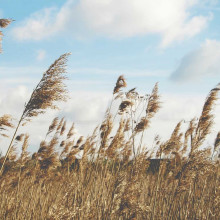The minimum land area to sustain a human
Charlie asked us to field the question, "what is the minimum area required to sustain one human being in terms of oxygen and food?" Marika Ottman brought this cultivation conundrum to Marco Springmann, the Senior Researcher on Environmental Sustainability and Public Health at the University of Oxford...
In this episode

00:00 - How much land to feed a person?
How much land to feed a person?
Marika Ottman is on a mission to answer Charlie's question...
Marika - The Anglo-Saxons tried to answer this question with a concept of a hide. Around the 7th century hides were first defined as the amount of land required to sustain a household, which converts to approximately 120 acres.
On the forum: anthrogeek12 points out that the answer really depends on the climate, the region, and dietary needs.
We have historically been able to obtain our food only by collaborating within social groups and following food sources. Excellent point: in the spirit of collaboration I put this question to Marco Springmann, a researcher at the University of Oxford who studies environmental sustainability and public health. Perhaps he can give us the lay of the land…
Marco - Let’s start with the numbers; our current population of 7.2 billion people uses roughly 40 percent of the Earth’s surface for agriculture. Two thirds of agricultural land is used as pastures for grazing and one third for planting crops. If you divide the total area by total population we get an estimate for average agricultural land amount per person of about 7,000 square metres - that’s roughly the size of a football field.
Marika - An entire football pitch of provisions; now that’s a lot of space just for one person. However, this size could vary based on a whole slew of factors.
Marco - This is only a rough estimate, and actual land requirements will depend on factors such as the production methods used in the region and the dietary choices people make; for example, you wouldn’t need that big portion of land for grazing if you ate less meat. Add in there, technological improvements, reductions in food loss and waste, not eating too little or too much, and growing more of the foods that we know are healthy and we should be eating more of, such as fruits, vegetables, and legumes you'd go from a whole football field to only the penalty zones, or to an Olympic size swimming pool if that’s more your thing.
Marika - an Olympic pool size plot of land is about 12 hundred square metres. Perhaps the best way to manage such a large plot of land would be to pool your resources then everything should go just swimmingly!
Marco - Now that you’re standing before your Olympic plot of land you just need to start farming. For that you might need some good friends and machinery that help you plough. Set aside some land from time to time to let it recover. If you add up all the land requirements that are needed for additional people and all that equipment and machinery you might soon be back at the size of an average country.
Marika - Thanks Marco for giving us some food for thought. Perhaps it is better that we all stick together to ensure we have enough food.
Speaking of sticking, next week we’re answering this question from Martin Fennel:
What’s the science behind non-stick pans? What prevents the sticking?
Georgia - What do you think? You can email chris@thenakedscientists.com, find us on Facebook, tweet @nakedscientists or join in the debate on the forum - thenakedscientists.com/forum.
Related Content
- Previous Life in the Year 2100
- Next Circumcision Prevents HIV










Comments
Add a comment